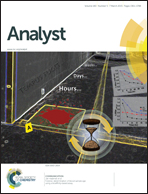Spectral characterization of postage stamp printing inks by means of Raman spectroscopy†
Abstract
Time travel through 150 years of Italian postage stamp issues has allowed defining the evolution of the recurring pigments in stamp designs by means of Raman and FTIR spectroscopy. Numerous exemplars have been analyzed, covering the entire production of stamps for both the Italian Kingdom and Republic. Raman and FTIR spectra showed the changeover from Prussian blue to copper phthalocyanine inks in 1958. The entire succession for red inks was also recognized to develop from the original cinnabar to red ochre and minium and finally to red azo pigments. The changes in orange printing ink proceeded on a similar path. The first orange Italian exemplar was printed employing a mixture of chrome orange and red ochre. In 1929 this combination was replaced by azo pigments. Green stamps belonging to the first issues entailed the choice of blue and orange inks, namely chrome orange and Prussian blue. Later on, an ink composed mainly of phthalocyanine was employed as the green dye. The merging of data coming from Raman microscopy and FTIR-ATR spectroscopy, both non-destructive techniques, has allowed the characterization of stamp designs and potentially provides direct and fast evidence for the recognition of forged exemplars.


 Please wait while we load your content...
Please wait while we load your content...